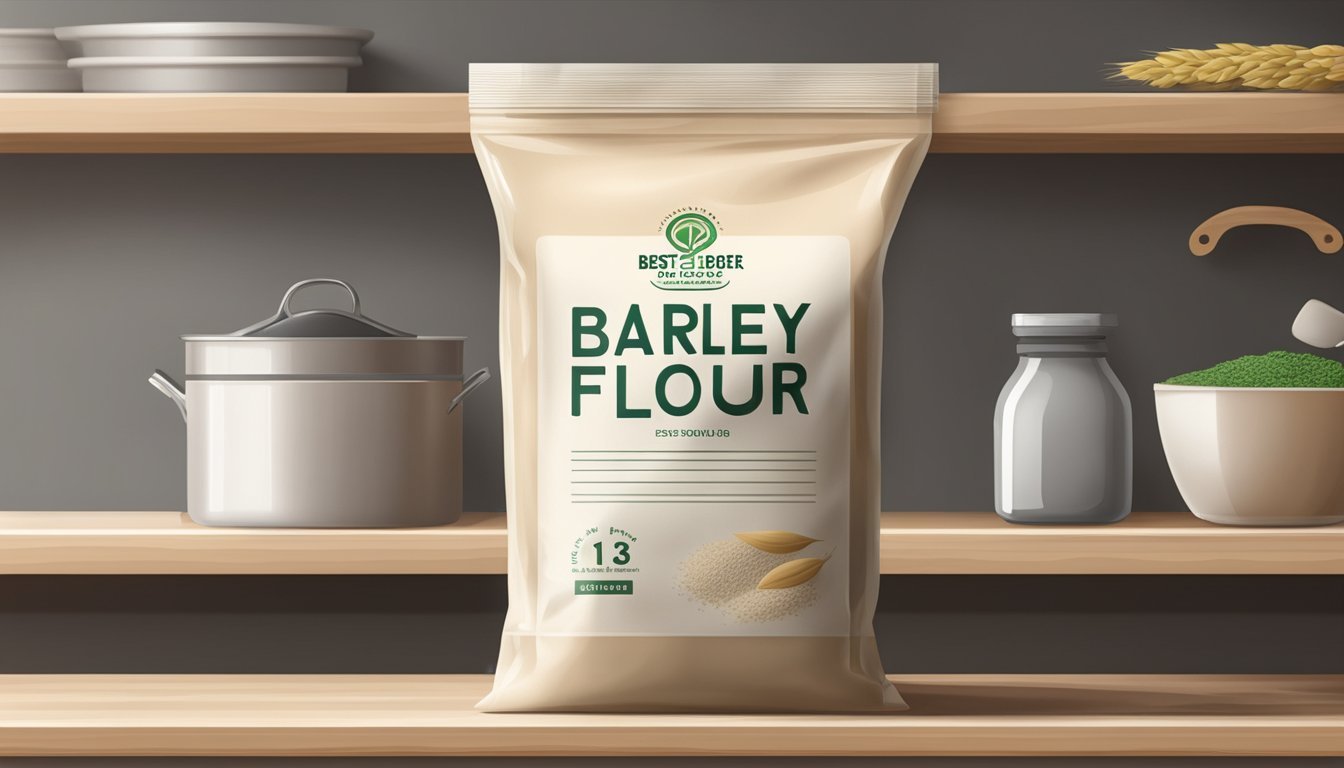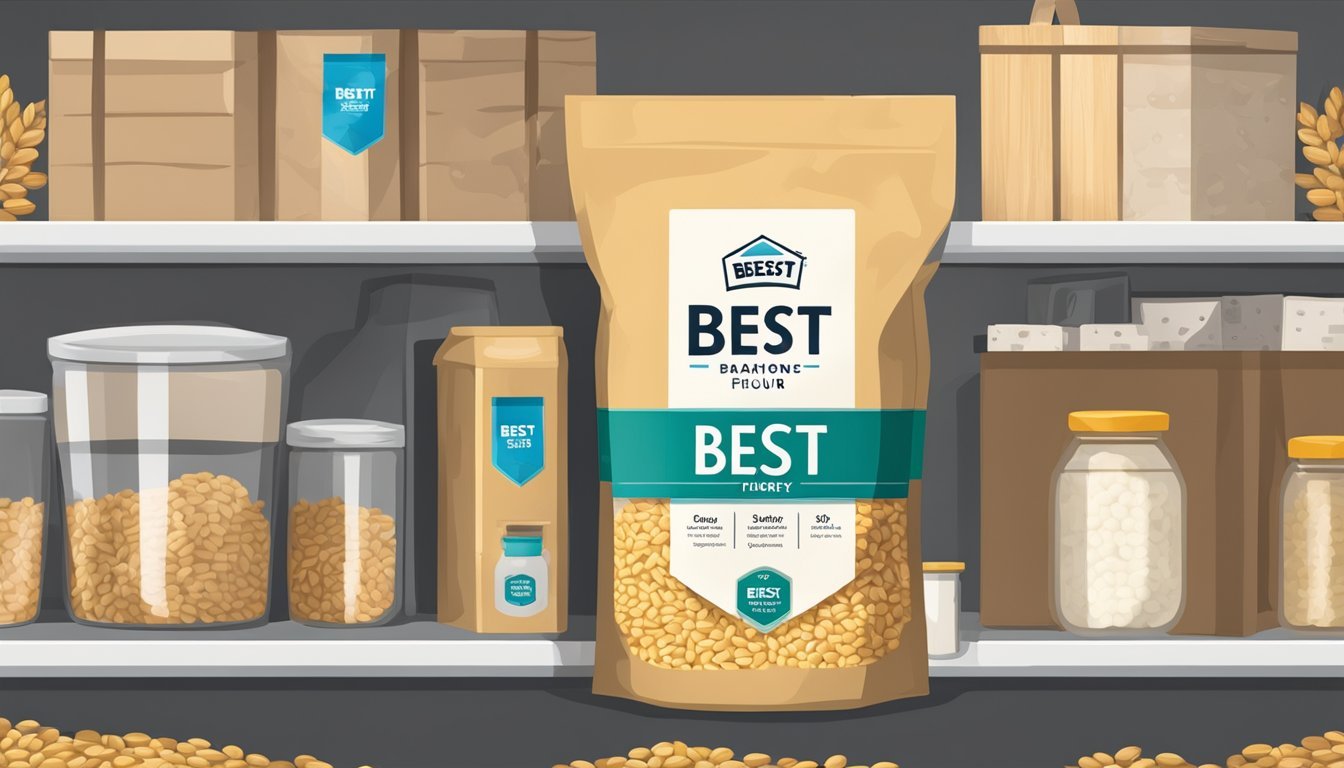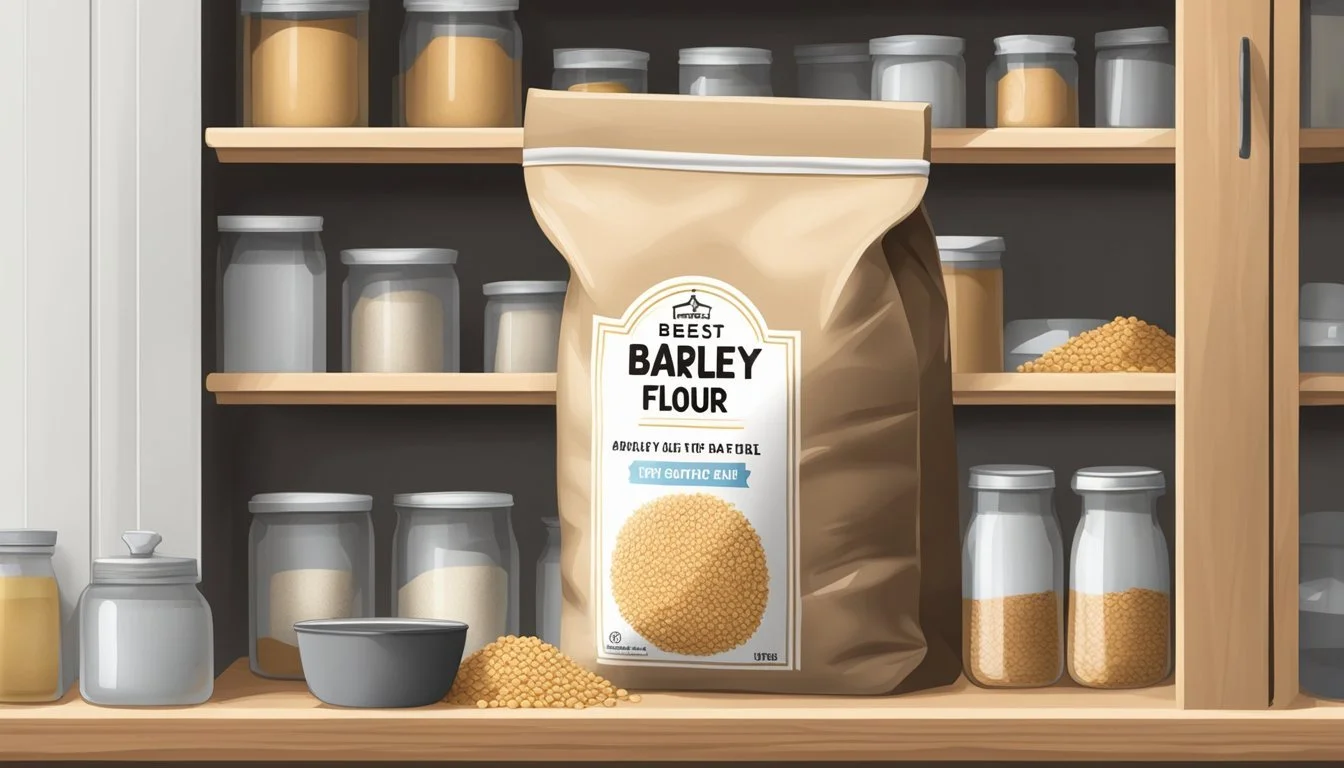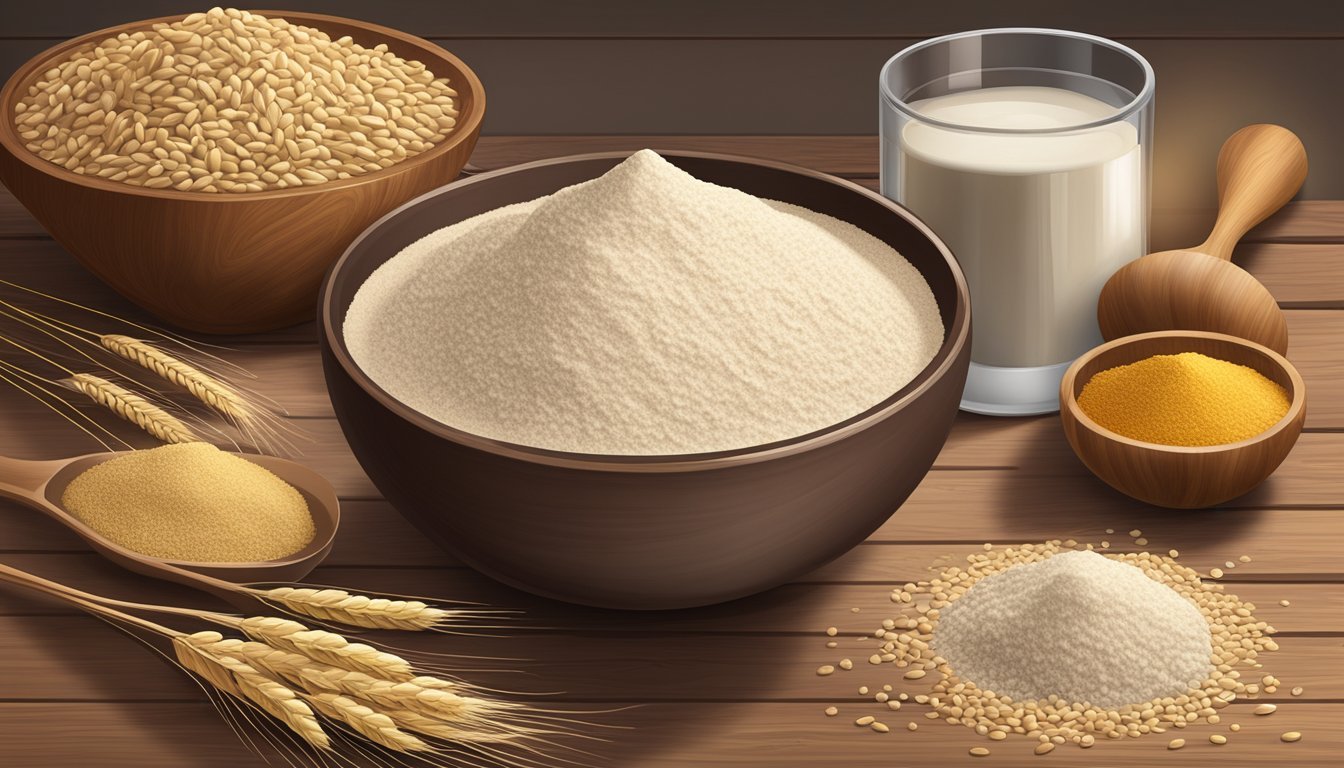How Long Does Barley Flour Last?
Shelf Life and Storage Tips
Barley flour, a product derived from grinding whole barley grain, is a nutritious alternative to traditional wheat flour, favored for its slightly nutty flavor and rich nutrient profile. It is a versatile ingredient used in a variety of baking recipes, from breads (how long does bread last?) to biscuits. The shelf life of barley flour is a key consideration for both consumers and manufacturers, as it affects the flour's quality and nutritional value.
The longevity of barley flour is influenced by storage conditions. When stored properly in a cool, dry place at a temperature around 65°F and with about 60% humidity, barley flour can maintain its quality. The shelf life typically ranges from six months up to a year under these ideal conditions. However, without optimal storage, barley flour tends to have a shorter lifespan.
To maximally preserve the quality of barley flour, it's often recommended to store it in airtight containers. Refrigeration or freezing can extend barley flour's usability, where it can remain fit for consumption for several months, and up to four months when stored in the freezer. These methods are effective in protecting the flour from factors that can hasten spoilage, such as excess moisture, temperature variations, and pests.
Basics of Barley Flour
Barley flour is derived from barley, offering a nutritious alternative to more common flours and differing notably in composition and potential uses.
Definition and Types
Barley flour is made from a cereal grain known as barley. This flour is primarily categorized based on the barley grain used, which can be either hulled or pearled. Hulled barley flour is made from whole grain barley, with only the inedible outer shell removed, retaining most of the nutritional value. Pearled barley flour, on the other hand, is made from barley grains that have been polished to remove the bran layer, resulting in a product with fewer nutrients.
Nutritional Value
Barley flour is known for its significant fiber content, particularly beta-glucan, which is beneficial for heart health. It is also a source of essential nutrients such as manganese, selenium, and thiamine. Relative to all-purpose wheat flour, barley flour contains less gluten, which makes it less suitable for bread making on its own yet beneficial for those looking to reduce gluten intake. However, it is not gluten-free and is not suitable for those with celiac disease or severe gluten intolerance.
Nutrient Benefit Fiber Supports digestive health Beta-glucan May improve cholesterol levels Manganese Essential for enzyme function Selenium Has antioxidant properties
Barley Flour vs. Other Flours
When compared with other flours like wheat, rye, or all-purpose flour, barley flour offers a distinct taste and texture. It tends to provide a nuttier flavor and is less processed, particularly in its whole grain form. Due to its lower gluten content, it doesn't provide the same structure and elasticity as bread flour (how long does bread flour last?) which is high in gluten, often requiring it to be mixed with other flours for certain recipes. Barley flour can be an excellent ingredient in quick breads, cookies, and crackers but may not be the best choice for traditional yeast breads unless combined with high-gluten flours.
Determining Freshness
To ensure barley flour is fresh and safe to use, one should check for sensory indicators of quality and review the label and expiration date for guidance.
Sensory Indicators
When assessing the freshness of barley flour, one's senses are reliable tools. Smell is a primary indicator; fresh barley flour should have a subtle, nutty aroma. An off-odor or sour smell suggests spoilage. Texture also plays a critical role; high-quality flour should feel smooth and powdery. Any lumps or irregularities may indicate exposure to moisture or age. Look for discoloration, such as a dull or grayish tone, which can signal degradation. Lastly, though less apparent, taste should only be considered if the previous indicators do not raise concerns; it should have a neutral, grain-like flavor without any bitterness.
Label and Expiration Date
The label on the packaging of barley flour often provides a "best by" or expiration date, which is the manufacturer's estimate for peak quality. These dates do not always correlate with the safety of the product but give a guideline for optimal freshness. After this date, the flour's quality may begin to decline. It's essential to follow storage recommendations on the label, such as keeping the flour in a cool, dry place, to maximize longevity.
Factors Affecting Shelf Life
When considering the shelf life of barley flour, two critical factors play prominent roles: exposure to elements and the type of packaging or container used. These aspects directly influence the duration for which barley flour maintains its quality.
Exposure to Elements
Barley flour's shelf life is significantly impacted by its exposure to various elements. These include:
Air & Oxygen: When barley flour is exposed to air, the oxygen content can lead to oxidation, affecting freshness and flavor.
Moisture: Excessive moisture can facilitate mold growth and spoilage.
Temperature: Both high and low temperatures can affect barley flour; cooler temperatures are preferred to slow down any biological processes that may cause deterioration.
Light: Direct sunlight and bright light can degrade the quality of barley flour over time, potentially changing its taste and nutritional content.
Packaging and Container
The choice of packaging and the container also determines the longevity of barley flour:
Airtight Containers: Using an airtight container is essential for prolonging the shelf life of barley flour by protecting it from moisture, air, and pests.
Material of the Container (Glass vs Plastic vs Mylar Bags):
Glass: Heavy, breakable, but it provides a good barrier against air and light, especially if tinted or stored away from light.
Plastic: Lighter and less fragile but can be permeable to air and odors over time. Not all plastic containers are created equally airtight.
Mylar Bags: Known for their strong barrier qualities, these bags are effective for keeping out light, moisture, and oxygen when properly sealed.
Storage Guidelines
Proper storage of barley flour is crucial for maintaining its quality and extending its shelf life. The following guidelines can help ensure that barley flour remains fresh and usable for as long as possible.
Ideal Conditions
Barley flour thrives in conditions that are cool, dry, and dark. Exposure to heat and light can expedite the degradation process, resulting in a shorter shelf life. It's imperative to store barley flour away from any sources of heat and light to preserve its freshness.
Pantry Storage
When kept in the pantry, a cool and dark environment away from direct sunlight is recommended. Barley flour should be placed in an air-tight container to prevent exposure to air and moisture, which can lead to spoilage. Under these conditions, barley flour can maintain its quality for approximately 3 months.
Refrigerator and Freezer Storage
For longer storage, refrigerating or freezing barley flour can significantly extend its shelf life. In the refrigerator, barley flour should be sealed in an air-tight container or vacuum-sealed bag. This method can keep barley flour viable for up to 4 months. When freezing, ensure the flour is within a thoroughly sealed container or bag to avoid freezer burn, which can maintain its quality for up to 1 year. Remember that before using, the flour should be brought back to room temperature to prevent any condensation which could affect its quality.
Preventing Spoilage and Pests
Proper storage of barley flour is crucial for preventing spoilage and infestation by pests. Using airtight containers and monitoring for signs of deterioration helps maintain its quality.
Protecting Against Contaminants
To protect barley flour from contaminants like mold and mycotoxins, one should store it in airtight containers. These containers thwart the influx of moisture and air, which can accelerate spoilage and mold growth. For additional protection, keep the barley flour in a cool, dry place, away from direct sunlight and fluctuating temperatures that can also foster mold.
Dealing with Insects
Pests, particularly weevils and other insects, are attracted to grains. Store barley flour in sturdy, airtight containers to deter infestation. Regularly inspect the flour for any signs of insects; presence may indicate a need to discard the product and cleanse the storage area thoroughly to remove any remaining pests.
Signs of Spoilage
Be vigilant for these indicators of spoilage in barley flour:
Visual changes: Any discoloration or clumping might suggest moisture has compromised the flour.
Odor: A musty or "off" smell is a strong sign that the flour has spoiled.
Texture: If the flour feels gritty or has hard lumps, it may have been affected by moisture or pests.
It's important to discard any barley flour that shows these signs of spoilage to prevent potential health risks.
Usage and Cooking with Barley Flour
Barley flour is a versatile ingredient in the kitchen, often used for its nutritional benefits and unique characteristics in various recipes.
Culinary Uses
Barley flour is incorporated into an array of culinary applications, notably in the crafting of baked goods. Bakers utilize barley flour to create a distinctive texture and flavor profile in products such as cakes, pastries, and especially in breads where its subtle nuttiness complements the overall taste. It is not uncommon to find it in flatbreads and even as a thickening agent for soups and sauces.
Mixing with Other Flours
Incorporating barley flour with other flours such as all-purpose flour is frequent, as this combination mitigates barley flour's low gluten content, which on its own can hinder proper rising in yeast-leavened breads. Typically, a ratio of one part barley flour to three parts all-purpose flour is recommended to maintain structural integrity in bread while infusing the nutritional benefits of barley.
Bread Making: For bread recipes involving yeast, maintaining a balance between barley and all-purpose flour ensures adequate rise and texture.
Cake and Pastry: When making cakes or pastries, substituting a small portion of the required all-purpose flour with barley flour enhances nutrition without compromising the delicate structure.
Tips for Baking
When baking with barley flour, it is crucial to consider its lower gluten content, which requires adjustments to traditional recipes.
For optimal results in bread, it's advisable to up the yeast content slightly or allow for longer rising times to achieve the desired level of lightness and chew.
Keep an eye on baking times, as barley flour can impact how quickly goods brown due to its different composition compared to all-purpose flour.
By applying these adjustments, chefs and baking enthusiasts can successfully incorporate the health benefits and unique flavors of barley flour into their cooking repertoire.
Maximizing Barley Flour Longevity
To maintain the quality of barley flour over time, attention to storage conditions and techniques is crucial. Proper storage can significantly extend the flour's shelf life, helping to keep it fresh and usable for longer periods.
Best Practices for Long-Term Storage
Proper Sealing: Ensure that barley flour is stored in an airtight container. A vacuum-sealed bag is ideal, as it removes air that could accelerate spoilage.
Oxygen Absorbers: Consider using oxygen absorbers in the container to further extend shelf life by preventing oxidation.
Humidity and Temperature: Store the flour in a cool and dry place. High humidity and temperature can lead to the development of mold or pests:
In the Pantry: Up to 3 months at room temperature.
In the Refrigerator: Up to 4 months.
In the Freezer: For maximum longevity, freezing the flour can extend its shelf life to a year.
Revitalization Techniques
Freeze: If stored in the freezer, barley flour may clump together. When removed from the freezer, let it come to room temperature and fluff it before use.
Check Frequently: Regularly inspect the barley flour for any changes in color, texture, or smell, which could indicate spoilage. If any of these signs are present, it is safer to discard the flour.
FAQs and Additional Tips
In the pursuit of maintaining barley flour at its best, understanding its shelf life plays a crucial role. This section addresses common questions and provides insight into alternatives for those considering different grains and flours.
Common Questions
How long can I expect barley flour to stay fresh?
Barley flour, when stored properly, generally remains fresh for up to three months at room temperature. Placing it in the refrigerator or freezer can extend its shelf life to approximately four months.
What signs indicate that barley flour has gone bad?
Smell: A rancid odor suggests spoilage.
Taste: A bitter or sour taste is a warning sign.
Visual: Discoloration or unusual texture, along with the presence of insects or their larvae, indicates the flour should be discarded.
Can I freeze barley flour for extended freshness?
Yes, barley flour can be frozen. Seal it in an airtight container or vacuum-sealed bag to maximize freshness.
Alternative Grains and Flours
Grain Alternatives with a Nutty Flavor:
Buckwheat: A gluten-free option with a rich, earthy flavor.
Quinoa: Offers a subtle nuttiness and is rich in protein.
Spelt (how long does spelt last?): An ancient wheat variety with a mild, nut-like taste.
Flour Options for Different Dietary Needs:
Amaranth, Teff, and Sorghum: (how long does sorghum last?) Gluten-free alternatives with distinct flavors.
Oats and Brown Rice: Often used in gluten-free baking, each providing their unique taste and texture.
Millet and Corn: Lighter options that are well-suited for breads and baked goods.
When choosing alternative grains or flours, consider their distinctive tastes and how they may impact the flavor profile of your recipes. Always store whole grains and flour alternatives in a cool, dry place to preserve their freshness and prevent them from becoming rancid.
Barley Flour in Dietary Cultures
Barley flour has emerged as a significant ingredient across various dietary cultures due to its nutritional value, offering a blend of vitamins, minerals, and fiber.
Global Trends
In the global culinary scene, barley flour is recognized for its utility in both traditional and contemporary cuisines. This grain, rich in fiber and containing moderate amounts of protein, has been adapted into a myriad of meals, serving as a staple food in numerous countries.
Middle East & Africa: Utilized in traditional flatbreads and porridges.
Europe: Often incorporated into artisan bread, providing a distinct nutty flavor and dense texture.
Asia: Used in noodles and a range of regional specialty baked goods.
As gluten awareness increases, barley flour, which contains gluten, isn't suitable for those with celiac disease. However, its use in whole grain flours is favored by those seeking to increase fiber intake without resorting to gluten-free options.
Health and Dietary Considerations
Barley flour is lauded for its health benefits in various diets. The grain's composition makes it a favorable choice for those aiming to enrich their meals with essential nutrients.
Fiber: Enhances digestive health and is linked to lower cholesterol levels.
Vitamins & Minerals: Supplies B-vitamins, iron, and selenium, supporting metabolic processes and antioxidant defenses.
Incorporating barley flour into the diet can add variety to meals while providing substantial nutritional value. It remains important, however, for individuals to be mindful of its gluten content when considering dietary restrictions.
The Science of Barley Flour Shelf Life
The shelf life of barley flour is influenced by several internal and external factors that cause chemical and physical changes. Understanding these factors can help in maximizing its freshness and usability.
Chemical and Physical Changes
Barley flour contains oils concentrated in the germ, which are prone to rancidity over time, especially when exposed to oxygen, moisture, and warm temperatures. The grain's bran contributes to the flour's shelf stability; however, once the protective layer is removed during processing, the flour becomes susceptible to spoilage. Moisture absorption can lead to mold growth and spoil the flour prematurely.
In terms of storage conditions, temperature plays a crucial role in preserving the quality of barley flour. Ideally, it should be stored in a cool, dry place. Low temperatures, such as those found in refrigerators and freezers, slow down the degradation processes. It's worth noting that unopened barley flour can last between 6 months to 1 year, while opened packets can remain good for about 3-4 months.
Research and Studies
Recent studies have investigated how processing methods affect barley flour's longevity. For instance, the removal of the germ and bran during milling can decrease the flour's shelf life due to the loss of natural antioxidants and the exposure of oils to oxidizing elements. These changes can be identified through scientific analysis measuring peroxide values and examining microbial spoilage.
Furthermore, research has focused on the shelf life of barley when stored under optimal conditions. Refrigeration can extend the flour's shelf life by up to 4 months, while freezing can preserve it for up to a year. Here is a brief summary of shelf life based on storage methods:
Storage Method Approximate Shelf Life Pantry (Unopened) 6 months to 1 year Pantry (Opened) 3-4 months Refrigerator Up to 4 months Freezer Up to 1 year
To mitigate spoilage risks, proper packaging that limits exposure to air, light, and moisture is recommended according to these studies.












